Puppermint Dog Treats
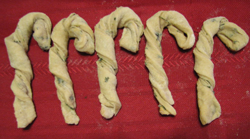
An added bonus, the peppermint and parsley help with bad breath, which will thrill your guests.
Ingredients:
1 cup flour
½ tsp salt
1 tablespoon parsley
1 ½ tablespoons flaxseed oil
¼ teaspoon peppermint oil
½ cup low-sodium chicken broth
Parchment paper
Directions:
Mix flour, salt, and parsley together in mixer.
Add flaxseed and peppermint oil, mix.
Add chicken broth; mix until all dry ingredients are moistened
Roll dough out on floured surface to a 1/8” thick sheet.
Cut into ¼ – ½” inch strips.
Fold strips in have and twist together, curving one end over to make a candy cane shape.
Place on cookie sheet lined with parchment paper
Bake at 375 for 15-20 minutes
Makes approximately 10 candy canes
Allow to cool thoroughly before giving to your dog!
Pumpkin Paw Prints Recipe
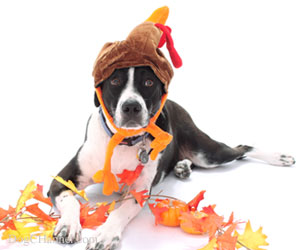
The recipe comes from Roberta Deen of Capers Catering Company in Los Angeles. She is one of the chefs who contributed to the book The Culinary Canine: Great Chefs Cook for Their Dogs- And So Can You!
Easy to make our dogs gobbled them up. They would also make great dog lover gifts to take to your friends this holiday season or any time of year. Package them up in cellophane or a nice tin and you’ll have your friends barking for the recipe.
Ingredients:
1 cup plain pumpkin puree (fresh or canned)
1 cup peeled, 1/4” diced, lightly blanched fresh pumpkin
1/2 cup roasted pumpkin seeds, coarsely chopped
1 cup quick-cooking oats
2 cups whole-wheat flour
1 cup all-purpose flour
1/2 teaspoon cinnamon
1/2 cup molasses
1/2 cup honey
1/2 cup unsweetened applesauce
1/2 cup canola oil
Directions:
Preheat oven to 325 (300 if using a convection oven)*
Mix above ingredients in a large bowl
Add water to achieve a chocolate-chip cookie like consistency
Line baking sheets with parchment paper
Drop by teaspoons (for the petite puppies) and Tablespoons (for the big guys) onto baking sheets about 2 inches apart
Flatten into rounds with a fork in a cross-hatch pattern
Bake for 10 minutes
Switch the baking sheets front to back, top to bottom and bake for 5-10 minutes longer until golden and firm – adjusting time for teaspoons (a bit less) and for tablespoons (a bit longer)
Turn off oven and leave the door open until the treats cool completely
Yield depends upon size of the cookie
Treats should be fed in moderation. Consult your veterinarian any time you are making changes to your dogs food or diet.
Football Dog Treats: Touchdown Tasties
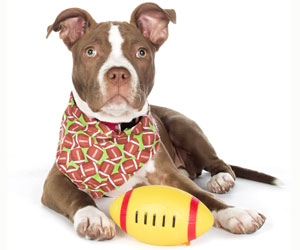
Check out these pawsome football-shaped dog treats Lucy Postins, CEO of The Honest Kitchen, created in honor of game day.
Ingredients
1 cup dehydrated dog food
¼ cup ham, diced
3 tbsp grated American or Cheddar cheese
½ *Avocado, mashed
1 free range egg, lightly beaten
3/4 cup warm filtered water
Directions
Preheat the oven to 350°F. Hydrate the dog food with the warm water and stir. Thoroughly mix in the remaining ingredients to form a batter.
Use your hands to form the mixture into “football” shapes, and place onto a greased or non-stick baking sheet.
Bake in a 350°F oven for 20 minutes.
Cool completely before serving.
Treats can be stored in an airtight container in the fridge.
*Although avocado stones are poisonous to dogs (and the stone as well as the tough skin could potentially be a choking hazard), the flesh itself is fine for occasional feeding in small quantities, and is a great source of natural, healthy oils. Take care to keep avocado skin and stones out of your pet’s reach and dispose of them (as well as other hazardous food scraps like onion and cooked meat bones) in a secure trash can that they can’t easily raid while you’re enjoying the game. Learn about other fruits and vegetables you can feed your dog: Fruits for Dogs, Vegetables for Dogs.
Make Your Own Chicken Jerky Dog Treats
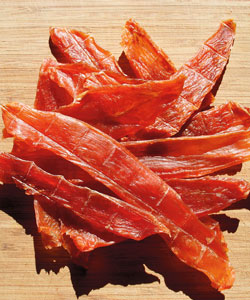
If you choose to feed your pet jerky treats, one option is to dry your own treats using a food dehydrator or your oven. This allows you to buy local, high-quality meats, giving you peace of mind about the safety of the ingredients.
Jerky Basics
Dehydration preserves foods by removing moisture, which inhibits the growth of microorganisms. You can dehydrate most raw meats, such as slices of beef, chicken, turkey, fish, or liver, as well as many fruits and vegetables, such as sliced apples, sweet potatoes, and carrots.
Several brands of small dehydrators are reasonably priced and easy to use. These machines have stacked or slide-out trays that hold the food to be dehydrated. A motor provides heat and powers a fan that blows hot air over the food. A tray at the bottom catches excess moisture.
You can also dry foods in your oven — on a cookie sheet — if it can be set at a low enough temperature. The lowest temperature for many ovens is 150 degrees Fahrenheit, and that’s fine. Prop the oven door open a few inches with a towel so hot air laden with moisture can escape. This works well, but because your oven is also heating the air in the kitchen, it uses more energy than a food dehydrator would.
Store dehydrated foods in airtight containers in the refrigerator or freezer. Protect these foods from moisture and humidity, or they will spoil.
The American Veterinary Medical Association advises pet owners who feed jerky treats to do so in small quantities and only on occasion, especially with small-breed dogs.
Chicken Jerky Strips
The thinner you slice the meat, the less time it takes to dry. Popping the meat into the freezer for about 15 minutes beforehand makes it easier to slice thinly.
Ingredients
1 1/2 pounds boneless skinless chicken breast tenders, sliced into strips about 1/8 to 1/4 inch thick
1/2 cup vegetable oil
Directions
Rinse off chicken breast and remove any fat. Fat slows down the dehydrating process and makes your jerky spoil faster. Slice the chicken with the grain. This will help make the jerky even chewier.
Lightly coat the chicken slices with vegetable oil to prevent sticking.
Place the chicken breast strips evenly on the tray, leaving space between them and making sure they do not touch each other.
Once they are all in the dehydrator, turn it on and set the temperature to 140 degrees Fahrenheit.
The jerky will probably take between three and 12 hours to fully dry, depending on how thick you cut your slices. Start checking it once every hour after the first hour. To check it, open up the tray and take one slice out. Cut it open with a sharp knife and examine the inside. You should see no moisture at all, and it should be the same color throughout. If it’s not finished, put it back in for another hour. Once it gets close, check every half hour.
Once your jerky is done, store it in airtight containers. Write the date you made it on them. Out of the refrigerator, the treats last about 10 days in an airtight container. They’ll keep in the refrigerator for approximately three weeks. They can also be frozen for up to eight months.
9 Things You Need to Know About Your Senior Dog’s Diet Needs
Most dog owners eventually face the challenge of properly feeding a geriatric dog. About one-third of all dogs in the United States are 11 or older, and dogs have an average life span of about 14 years, says Kathleen Hefner, DVM, a specialist in nutrition and nutritional counseling at the Animal Hospital of Saddle River in N.J.

Hefner emphasizes, however, that each dog is unique, so owners should consult their veterinarians and rule out any health problems before making dietary changes. All senior dogs are not the same, she says. You have to look at the more subtle things. You’ll want guidance on your individual pet’s needs.
But the majority of aging dogs face some common physical changes that require dietary changes to address them:
Dogs’ appetites can decrease as they age, so if they eat less, a calorie-dense diet can ensure they still get enough nutrients.
Dogs might also eat less because of pain from periodontal disease; more palatable, easier-to-chew food helps ensure Fido doesn’t go hungry.
Phosphorous and sodium can aggravate kidney problems, heart disease, and hypertension. If your dog has these illnesses, look for a diet with less of these two elements.
A sufficient amount of zinc helps keep the skin, coat, and immune system healthy.
Antioxidants, such as vitamins A, C, and E, and beta-carotene, are all believed to fight cancer and slow aging, so owners may want to supplement these if their dogs’ food doesn’t already include sufficient amounts.
Additives for joint health, such as glucosamine and chondroitin, often ease the aches of arthritis by maintaining the healthy cartilage that cushions the bones. Many senior dog foods include these ingredients, also available as supplements.
Aging dogs tend to have more gastrointestinal distress, so a diet with increased fiber can help prevent constipation.
Older dogs still require protein – vital to the body for cell repair and muscle maintenance – but can’t metabolize it as efficiently. They need higher-quality protein with a complete range of essential amino acids.
The omega-3 fatty acids found in fish oil and flaxseed oil can help alleviate a dull, dry coat and dry skin, as well as aid immune-system function.
Cheese Pleaser Dog Treats Recipe
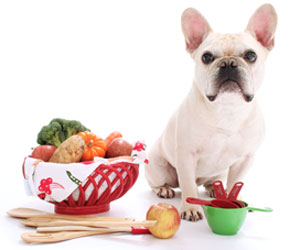
Whether you make all of your dog’s food or just want to give your dog a special culinary surprise, this cheesy Pooch Munchies recipe, from the Three Dog Bakery, is sure to have your dog begging for more.
Get the whole family involved for this quick and easy dog recipe.
Prep Time: 15 min
Bake Time: 12 min
Ingredients:
3 cups whole wheat flour
1 teaspoon garlic salt (do not use fresh garlic)
1/2 cup soft bacon fat
1 cup shredded cheese
1 egg, beaten slightly
1 cup milk
Baking Instructions:
Preheat oven to 400 ºF.
Place flour and garlic salt in a large bowl. Stir in bacon fat. Add cheese and egg.
Gradually add enough milk to form a dough.
Knead dough and roll out 1-inch thick.
Use a dog bone-shaped cookie cutter to cut out dough. (Don’t have a cookie cutter? Use an upside down glass to cut out round cookies)
Place dog bones on a greased cookie sheet and bake about 12 minutes or until they start to brown.
Cool and serve.
Homemade Dog Food for Elderly Dogs
Seniors’ Nutritional Needs
In general all dogs need the same basic essentials in their diets. Protein, fats and carbohydrates are all necessary to keep your dog healthy. You’ll need to do some adjusting for your geriatric pooch, though. As your dog ages his protein needs stay the same, but his metabolism slows down. That means he’ll need to get the same amount of protein but do it while taking in less calories. Increase the fiber, cut the carbs and use sources of lean protein like poultry, fish, lamb or extremely lean beef to accomplish this.
Supplements
To assure that your older dog is getting all of the vitamins and minerals he needs, you might consider adding some human grade bonemeal and a few drops of a vitamin supplement to the food you make for him. Omega-3’s are another supplement that you can add that will help keep your dog’s joints and heart healthy as well as keep his coat shiny and soft.
Talk To Your Vet
Once you have a plan and know what you want to put into your elderly dog’s homemade meals, talk to your vet to get advice on foods and nutrients that your dog might need based on his health. Certain medical issues like kidney disease, heart disease or diabetes may affect what ingredients you can use in your dog’s food and how much of it you can put in. Show your vet the recipe you intend to use and get his thoughts. He’ll also be the best person to ask about vitamin supplements. Just because your dog is older doesn’t mean that he has a vitamin deficiency. Instead of OD’ing your dog on vitamins, make sure your vet recommends adding them — or any supplement — to his meals.
Basic Senior Recipe
A basic dog food recipe that will be tasty and healthy for your senior citizen canine is easily made by crumbling 1 pound of ground turkey into a large pot containing six cups of water and one teaspoon of dried rosemary. Stir to distribute the turkey and rosemary evenly and bring it to a boil over high heat. Once the mixture boils, reduce the heat to low and allow it to simmer for 20 minutes. Add 8 ounces of frozen vegetables, like carrots, broccoli and cauliflower — thawed and cut into small pieces — and cook for five minutes more. Remove the pot from the heat and allow it to cool to room temperature before you feed it to your dog. Store the leftovers in the fridge in a covered container.





